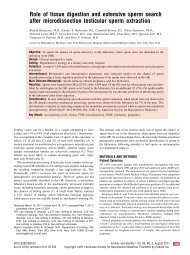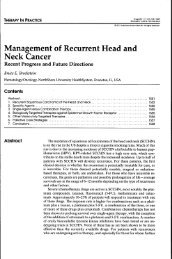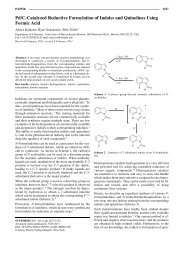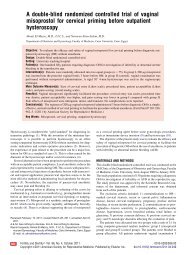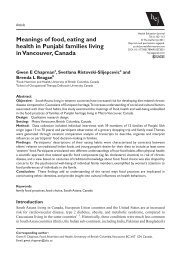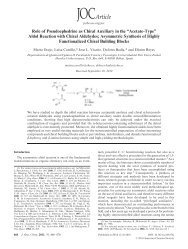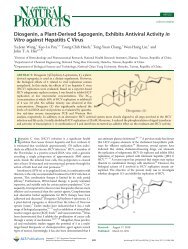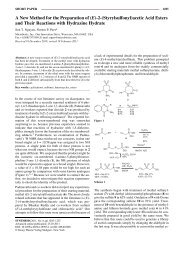Prenylated Polyhydroxy-p-terphenyls from Aspergillus taichungensis ...
Prenylated Polyhydroxy-p-terphenyls from Aspergillus taichungensis ...
Prenylated Polyhydroxy-p-terphenyls from Aspergillus taichungensis ...
Create successful ePaper yourself
Turn your PDF publications into a flip-book with our unique Google optimized e-Paper software.
Journal of Natural Products ARTICLE<br />
antiviral, antifungal) often quite different <strong>from</strong> those of their nonprenylated<br />
precursors. 15 17 Prenylation in polyhydroxy-p-terphenyl<br />
metabolites is rare, and to the best of our knowledge, only<br />
two compounds, prenylterphenyllin (8) and 4-deoxyprenylterphenyllin,<br />
have been reported to have this modification and<br />
exibited strong cytotoxicity. 6 In our case, six of the seven new<br />
isolated compounds are prenylated and the prenylation seemed<br />
to influence the cytotoxicity of this compound family. However<br />
our SAR data are not conclusive, and further investigation is<br />
required to clarify this aspect.<br />
’ EXPERIMENTAL SECTION<br />
General Experimental Procedures. IR spectra were recorded<br />
on a Nicolet NEXUS 470 spectrophotometer in KBr discs. UV spectra<br />
were recorded on a Beckman DU640 spectrophotometer. 1 H NMR, 13 C<br />
NMR, and DEPT spectra and 2D NMR were recorded on a JEOL JNM-<br />
ECP 600 spectrometer using TMS as internal standard, and chemical<br />
shifts were recorded as δ values. ESIMS was measured on a Micromass<br />
Q-TOF Ultima Global GAA076 LC mass spectrometer. Semipreparative<br />
HPLC was performed using an ODS column [YMC-Pack ODS-A,<br />
10 250 mm, 5 μm, 4 mL/min].<br />
Fungal Material. The fungal strain A. <strong>taichungensis</strong> ZHN-7-07 was<br />
isolated <strong>from</strong> the root soil of the mangrove plant Acrostichum aureum and<br />
was identified by ITS sequence. The voucher specimen is deposited in<br />
our laboratory at 20 °C. Working stocks were prepared on potato<br />
dextrose agar slants stored at 4 °C.<br />
Figure 1. Selected 1 H 1 H COSY, HMBC, and NOESY correlations of<br />
compounds 1 and 4 7.<br />
Fermentation and Extraction. Fermentation was carried out as<br />
follows. A. <strong>taichungensis</strong> ZHN-7-07 was cultured under static conditions<br />
at 28 °C in 1000 mL Erlenmeyer flasks containing 300 mL of fermentation<br />
media (mannitol 20 g, maltose 20 g, glucose 10 g, monosodium<br />
glutamate 10 g, KH2PO4 0.5 g, MgSO4 3 7H2O 0.3 g, yeast extract 3 g,<br />
and corn steep liquor 1 g, dissolved in 1 L seawater, pH 6.5). After 30<br />
days of cultivation, 30 L of whole broth was filtered through cheesecloth<br />
to separate the broth supernatant and mycelia. The former was extracted<br />
with ethyl acetate, while the latter was extracted with acetone. The<br />
acetone extract was evaporated under reduced pressure to afford an<br />
aqueous solution and then extracted with ethyl acetate. The two ethyl<br />
acetate extracts were combined and concentrated under reduced<br />
pressure to give a crude extract (40.0 g).<br />
Purification. The crude extract (40.0 g) was applied to a silica gel<br />
(300 400 mesh) column and was separated into five fractions (Fr.1 Fr.5)<br />
using a step gradient elution of petroleum ether/acetone. Fr.3, eluted with<br />
9:1 petroleum ether/acetone, was fractionated on a C-18 ODS column<br />
using a step gradient elution of MeOH/H2O and was separated into 10<br />
subfractions (Fr.3.1 Fr.3.10). Fr.3.7 was further purified by semipreparative<br />
HPLC (80:20 MeOH/H2O, 4 mL/min) to give compound 7 (50 mg,<br />
tR 9.8 min). Fr.3.8 was applied on semipreparative HPLC (80:20 MeOH/<br />
H 2O, 4 mL/min) to afford compound 6 (5.0 mg, t R 15.0 min). Fr.4, eluted<br />
with 8:2 petroleum ether/acetone, was fractionated on a C-18 ODS column<br />
using a step gradient elution of MeOH/H 2O and was separated into 10<br />
subfractions (Fr.4.1 Fr.4.10). Fr.4.5 was separated on Sephadex LH-20<br />
using CHCl3/MeOH (50:50) and further purified by semipreparative<br />
HPLC (70:30 MeOH/H 2O, 4 mL/min) to afford compounds 1 (9.5<br />
mg, tR 9.5 min), 3 (1.8 mg, tR 11.0 min), 10 (1.5 mg, tR 12.0 min), and 14<br />
(20.0 mg, t R 6.36 min), respectively. Compounds 4 (10.0 mg, t R 17 min), 11<br />
(25.0 mg, tR 5.5 min), and 12 (20.0 mg, tR 17.7 min) were also obtained<br />
<strong>from</strong> Fr.4.5, which was applied on Sephadex LH-20 using CHCl 3/MeOH<br />
(50:50) and purified by semipreparative HPLC (60:40 MeOH/H2O,<br />
4 mL/min). Fr.4.7 was applied on Sephadex LH-20 using CHCl3/MeOH<br />
(50:50) and further purified by semipreparative HPLC (70:30 MeOH/<br />
H2O, 4 mL/min) to yield 2 (2.0 mg, tR 14.0 min), 5 (11.0 mg, tR 15.0 min),<br />
8 (3.0 mg, t R 14.5 min), 9 (1.2 mg, t R 13.0 min), and 15 (5.0 mg, t R 9.9 min),<br />
respectively. Fr.5, eluted with 7:3 petroleum ether/acetone, was fractionated<br />
on a C-18 ODS column using a step gradient elution of MeOH/H 2O<br />
and was further purified by semipreparative HPLC (50:50 MeOH/H2O,<br />
4mL/min)togivecompound13 (30 mg, tR 9.8 min).<br />
Cytotoxicity Assay. Cytotoxic activities of 1 8 and 11 15 were<br />
evaluated by the MTT method using P388 and HL-60 cell lines and the<br />
SRB method using the A-549 cell line with ADM as positive control. 12<br />
Prenylterphenyllin A (1): colorless, amorphous solid; UV (MeOH)<br />
λmax (log ε) 216 (4.68), 282 (4.35) nm; IR (KBr) νmax 3397, 2965, 2935,<br />
2841, 1672, 1608, 1486, 1460, 1398, 1125, 1108, 1069, 820 cm 1 ; 1 H<br />
and 13 C NMR see Tables 1 and 2; HRESIMS [M þ H] þ m/z 423.1814<br />
(calcd for C25H27O6, 423.1808; Δ þ1.5 ppm).<br />
Prenylterphenyllin B (2): colorless, amorphous solid; UV (MeOH)<br />
λmax (log ε) 210 (4.65), 277 (4.39) nm; IR (KBr) νmax 3356, 2961, 2931,<br />
2849, 1608, 1521, 1485, 1459, 1399, 1263, 1172, 1105, 1071, 1019,<br />
823 cm 1 ; 1 H and 13 C NMR see Tables 1 and 2; HRESIMS [M þ H] þ<br />
m/z 407.1850 (calcd for C25H27O5, 407.1858; Δ 2.1 ppm).<br />
Table 3. Cytotoxicities against HL-60, A-549, and P-388 Cell Lines of Compounds 1 8 and 11 15 (IC50 (μM)) a<br />
1 2 3 4 5 6 7 8 11 12 13 14 15<br />
HL-60 1.53 38.46 28.24 9.89 11.83 76.65 10.12 2.75 9.86 10.98 11.04 77.56 16.52<br />
A-549 8.32 >100 >100 40.71 53.2 8.61 12.26 3.62 34.68 12.17 14.32 19.34 83.60<br />
P-388 10.89 12.57 86.16 2.70 16.5 1.57 75.72 1.99 28.06 17.76 9.13 46.83 96.89<br />
a<br />
Data represent mean values of three independent experiments and were determined by the SRB method using the A-549 cell line and the MTT method<br />
using P388 and HL-60 cell lines.<br />
1109 dx.doi.org/10.1021/np2000478 |J. Nat. Prod. 2011, 74, 1106–1110



